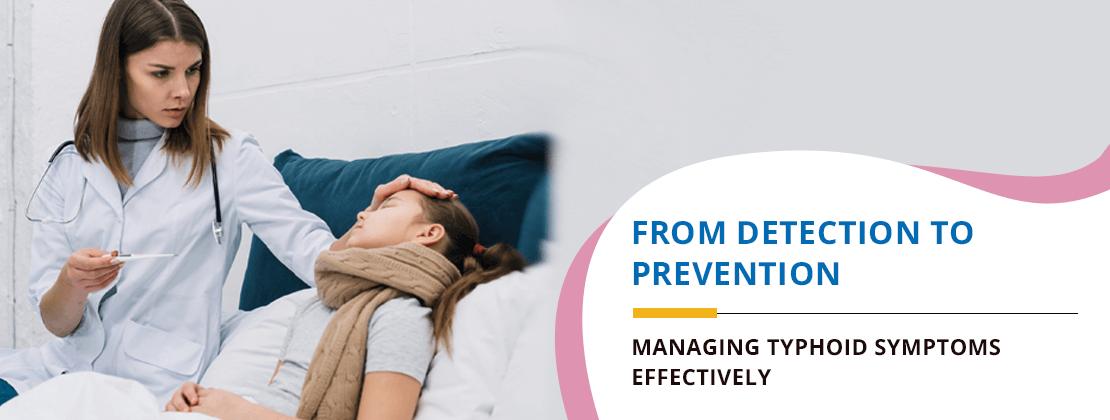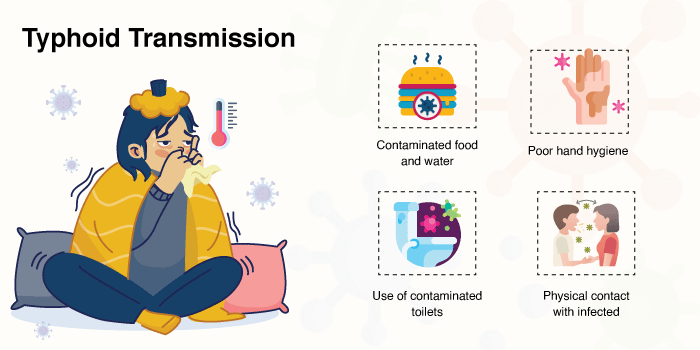
Home / Blog / From Detection to Prevention: Managing Typhoid Symptoms Effectively
Table of Contents
Did you know that in 2021, India became the country with the highest typhoid burden in the world? That year, 10 million cases were recorded.
Over the years, our country has been recording typhoid cases in increasing numbers. Possible reasons for this may include poor sanitation and limited access to clean water in some parts of our country.
Learning about the possible causes and symptoms of typhoid fever can help you reduce your risk or seek timely medical interventions.
In this article, we are discussing the key aspects of typhoid fever, including its transmission, symptoms, treatment, recovery time, and more.
As you read, you will also know how the team of infection specialists at HCG Hospitals approaches typhoid and other infectious diseases and helps their patients have a speedy and seamless recovery.
Typhoid is a life-threatening bacterial infection caused by the bacterium Salmonella typhi, a serovar or serotype of Salmonella enterica.
Typhoid progresses through four stages and exhibits various symptoms during these stages. The following are the different stages of typhoid fever.
Stage 1 or incubation stage: This stage occurs right after the patient is exposed to the bacteria. In the incubation stage, the bacteria reach the small intestine and multiply. This stage lasts for 7–14 days, and there will be no apparent symptoms.
Stage 2 or invasive stage: In this stage, symptoms such as fever, headache, and tiredness start appearing. Weight loss and hallucinations may also be observed.
Stage 3 or plateau stage: In this stage, the fever reaches its peak, and there are multiple severe symptoms: severe intestinal perforation, brain inflammation, inflammation of the pancreas, pneumonia, and other organ dysfunctions.
Stage 4 or defervescence stage: Severe health complications are seen if the infection is left untreated, and they may cause long-term health effects.
Typhoid often spreads through the consumption of food and water contaminated with faecal matter. The following are common sources of typhoid infection or typhoid fever causes:

The typhoid symptoms experienced may vary depending on the severity of the infection.

Becoming aware of different typhoid symptoms can help one seek timely medical attention.
Initially, the doctor will ask the patients about the symptoms they are experiencing and the duration, and check if there is any history of travelling to high-risk regions.
Based on the observations from the medical history assessment, different tests are recommended for typhoid detection.
Commonly recommended diagnostic tests for typhoid include:
Blood culture: This involves collecting and placing the blood sample of the suspected individual in an environment that promotes bacterial growth. This culture with bacterial growth is then examined for the presence of Salmonella typhi.
Stool culture: This involves collecting the stool sample of the suspected individual, culturing it, and examining it under a microscope for the presence of Salmonella typhi bacteria.
Bone marrow culture: For this test, bone marrow tissue is collected, cultured, and examined under a microscope.
Urine culture: The urine sample is collected, cultured, and examined under a microscope to look for the presence of typhoid bacteria. Urine culture is often not as effective as other cultures, and therefore it is rarely recommended.
Tests to detect antibodies produced against typhoid bacteria in the blood: The presence of antibodies against typhoid bacteria inside the blood indicates the presence of infection. Various tests look for antibodies produced against typhoid in the blood, and they include the Typhidot test, WIDAL test, and TUBEX test.
Tests to detect the DNA of typhoid bacteria in the blood: This test looks for the presence of DNA of Salmonella typhi in the blood, which confirms the presence of the infection. The PCR test is recommended for the same.
Antibiotics are the first line of typhoid treatment. Supportive care for typhoid is also recommended along with antibiotics for holistic typhoid fever recovery.

Antibiotics belonging to different classes are recommended for typhoid treatment.
These antibiotics use multiple mechanisms to achieve infection control. The following are the different antibiotics recommended for typhoid:
Supportive care is a critical part of typhoid management. While antibiotics control the infection, supportive care helps the patient recover better.
In most cases, typhoid is managed at home with a proper antibiotic course. However, in some cases, where the symptoms are severe or the infection is left untreated until it causes multiorgan dysfunction, hospitalisation may be required.
Hospitalisation for typhoid involves the administration of antibiotics through injections, IV drips, and symptom management.
The recovery time for typhoid fever may vary from one patient to another, depending on the severity of the infection. In the case of a mild infection, the patient may recover in 4–10 days. If the infection is severe, recovery may take 3-4 weeks.
In cases where the infection was left untreated for long periods and led to multiorgan dysfunction, the recovery may take even months.
Some of the signs of recovery from typhoid include improved appetite, improved energy levels, reduced fever and body pain, reduced diarrhoea, clearer thinking, reduced chest congestion, and the disappearance of rashes and discolourations on the chest and abdomen.
After the treatment, you must adopt measures that are going to help you recover faster and return to routine activities. Complete the antibiotic course as prescribed.
Typhoid fever treatment and the food you eat are closely connected. Therefore, ensure you eat nutritious food and drink enough water. You will also need enough rest until you recover completely.
Making certain adjustments to your lifestyle is crucial after typhoid fever recovery to reduce your risk of getting infected again.
Make sure the food you eat and the water you drink are clean. Consider the typhoid vaccine when you are travelling to less hygienic or high-risk regions. Practise regular handwashing and keeping your environment clean.
Prevention is found to be a highly effective tool against typhoid fever. There are different measures that one may take to reduce typhoid fever risk.

There are vaccines available to prevent typhoid infection. Two main types of typhoid vaccines include the inactivated vaccine (which contains the dead particles of Salmonella typhi) and the attenuated vaccine (which contains live but weakened particles of Salmonella typhi).
Both these vaccines work by stimulating antibody production by the immune system; this keeps it ready to fight off when there is an actual infection.
The effectiveness of the typhoid vaccine lasts for 2-3 years, and a booster dose may be required after that period.
Since poor hand hygiene is one of the biggest risk factors for typhoid, you must ensure that you and the people around you have good hand hygiene practices.
Also, you must ensure you have clean sanitation facilities where you live or work, as a large percentage of typhoid cases are caused by drinking contaminated water.
Take extra care when you are travelling to areas where typhoid is common. You may consider the typhoid vaccine two weeks before you leave. When you are there, ensure you drink clean water and eat clean food. Also, consider washing your hands regularly.
Once you are back, consider undergoing a typhoid test to make sure you have not contracted the infection.
You must see an infectious disease specialist or general physician if you have a fever that is gradually increasing, persistent headache, abdominal pain, and tiredness that does not improve.
You may also need a check-up if you have come in contact with individuals who have typhoid infection or if you have recently travelled to a region where typhoid infection is commonly present.
Both infectious disease specialists and general physicians carefully assess your symptoms, travel history, and medical history before recommending appropriate tests and necessary medical interventions.
At HCG Hospitals, Ahmedabad, we have full-fledged facilities to treat and manage different types of infectious diseases, including typhoid.
To sum it up, typhoid is one of the most common infections in our country, and we need to take necessary precautions to prevent it. Along with this, it is also important for us to understand its causes, risk factors, and symptoms, which can help us in combating this infection effectively.
At HCG Hospitals, Ahmedabad, our infectious disease specialists embrace an individualised and patient-focussed approach to the management of infectious diseases like typhoid, which helps in achieving higher cure rates for patients and allowing them to return to their routine activities at a faster rate.
Different tests recommended for typhoid fever are blood tests/cultures, urine cultures, and stool cultures. In some cases, bone marrow aspiration or biopsy may also be recommended for typhoid diagnosis.
Weakness, fever, and headache are often the earliest symptoms of typhoid.
Stages 1, 2, 3, and 4 are the different stages of typhoid fever.
In stage 1, the bacteria enter the bloodstream and develop an infection in the intestine or gut. There may be mild symptoms like headache, dry cough, and fever.
In stage 2, symptoms such as high fever, weakness, abdominal pain, nausea and vomiting, etc. are observed.
In stage 3, the symptoms become severe, and there may be internal bleeding in the stomach, inflammation in the brain, and dehydration, along with initial symptoms.
In stage 4, patients may experience multiorgan dysfunction, wherein inflammation is seen in the pancreas, heart inflammation, pneumonia, kidney failure, and meningitis.
Antibiotics are the most effective treatment for typhoid. The type of antibiotic depends on the severity of the infection.
For faster recovery from typhoid fever, it is important to complete the antibiotic course as prescribed by the doctor, stay hydrated, consume healthy foods, and rest adequately.
Complications of typhoid fever stem from not seeking medical treatment on time. Ignoring persistent symptoms and delaying the treatment can cause complications like intestinal damage, brain and nervous system complications, lung complications, and heart complications.
Yes, typhoid fever can result in long-term health effects if the treatment is delayed. Commonly seen long-term health effects in typhoid patients include intestinal perforation, neurological symptoms, and brain inflammation (meningitis).
To manage typhoid fever symptoms at home, you may follow the following measures:
Since this fever affects the gut, you need to ensure that your food choices are easy on your intestine. The following dietary changes are recommended during your recovery period:
a. Consume easily digestible carbohydrates
b. Consume easily digestible proteins
c. Limit your fibre intake
d. Avoid greasy or spicy foods
e. Drink enough water
If you suspect typhoid fever, consult an infectious disease specialist or a general physician.